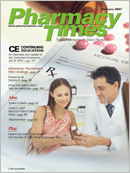Publication
Article
Pharmacy Times
JCAHO's 2007 National Patient Safety Goals
Author(s):
In June 2006, the Joint Commission onAccreditation of Healthcare Organizations(JCAHO) issued National PatientSafety Goals (NPSG) that became effectiveJanuary 1, 2007. The NPSG andthe requirements are selected by a SentinelAdvisory Group, a panel of nationalpatient-safety experts. The panelistsbase the recommendations on a comprehensiveevaluation of reported sentinel-event data, professional literature,and patient-safety information. They alsoconsider recommendations from variousmultidisciplinary professional resources,including pharmacy experts working in awide range of health care settings.1
The 2007 NPSG is JCAHO's fifthNPSG issuance. Since its inception,the NPSG program has promulgated15 goals. Some goals carry overfrom year to year, but JCAHO removes or"retires" goals from the list once they areformally incorporated in specific accreditationstandards.
2007 Goals
Table 1 contains an abridged version ofthe 2007 NPSG and the requirements.Specific and detailed NPSG descriptionsare available on JCAHO's Web site,www.jointcommission.org/PatientSafety/NationalPatientSafetyGoals/. Accreditedprograms requiring NPSG complianceinclude the following2,3:
- Ambulatory care and office-basedsurgery
- Assisted living
- Behavioral health care
- Critical-access hospital programs
- Disease-specific care
- Home care
- Hospital programs
- Laboratory programs
- Long-term care
- Medicare/Medicaid certification-basedlong-term care
- Health care networks
Pharmacy-related Goals
Medication safety continues its priorityplacement in 2 explicit NPSG (Goals 3and 8). Despite progress toward improvement,look-alike/sound-alike drugs remainserious issues, as does pharmacycontinuity of care. To help staff membersidentify potentially problematic drugnames, JCAHO provides a list of confusingnames on its Web site. Samplesinclude the following:
- Ephedrine and epinephrine
- Hydroxyzine and hydralazine
- Vinblastine and vincristine
- Metformin and metronidazole
Implementation expectations requireorganizations to select a minimum of 10look-alike/sound-alike drug combinationsand to develop error-prevention strategiesproactively.2 One recommendedintervention, for example, is text or formathighlighting on computer screens(eg, hydrOXYzine and hydrALAzine).4
Goal 8 focuses on pharmacy continuumof care and includes a new requirement:clinicians must provide a completelist of patients' current medications tothem at discharge. Experience and researchconfirm increased medicationerrorrisk at patient-transition points.Medication reconciliation between internaland external providers minimizeserrors. Medication reconciliation evaluatespatients' admission and dischargemedications and identifies and resolvesomissions, duplications, discrepancies,and potential drug interactions. Activehealth care providers then communicatethe reconciled list with posttransitionproviders, including those external to theorganization.2
Goal 2, improving communication,calls for standardizing abbreviations andsetting requirements for verbal and telephoneorders. The continued use of "donot use" abbreviations is one of the mostfrequent noncompliance accreditationfindings: 23% of organizations continueto use abbreviations now considereddangerous (Table 2).5,6
Final Thought
Many issues potentially affect healthcare and patient safety, including the following:
- Leadership
- Consumer rankings
- Marketing initiatives
- Financial incentives
- Professionalism
- Regulation
The authors of one study, however,report that JCAHO regulatory initiativeshave been among the most significantchange-producing forces.7
Dr. Zanni is a psychologist andhealth-systems consultant based inAlexandria, Va.
References
1. The Joint Commission on Accreditation of Healthcare Organizations. Facts about the 2007 National Patient Safety Goals. Available at: www.jointcommission.org/PatientSafety/NationalPatientSafetyGoals/07_npsg_facts.htm. Accessed November 21, 2006.
2. The Joint Commission on Accreditation of Healthcare Organizations. The Joint Commission Announces the 2007 National Patient Safety Goals and Requirements. Jt Comm Perspect. 2006;26:1-31.
3. The Joint Commission on Accreditation of Healthcare Organizations. 2007 National Patient Safety Goals. Available at: www.jointcommission.org/NR/rdonlyres/0F26F75F-B4B4-463F-B9CC-6B4723BFF9F0/0/2007_NPSG_presentation.ppt. Accessed November 28, 2006.
4. The Joint Commission on Accreditation of Healthcare Organizations. Facts about the 2007 NPSG's look-alike/sound-alike drug list. Available at: www.jointcommission.org/NR/rdonlyres/C92AAB3F-A9BD-431C-8628-11DD2D1D53CC/0/LASA.pdf. Accessed November 28, 2006.
5. The Joint Commission on Accreditation of Healthcare Organizations. Official "do not use" list." Available at: www.jointcommission.org/NR/rdonlyres/2329F8F5-6EC5-4E21-B932-54B2B7D53F00/0/06_dnu_list.pdf. Accessed November 28, 2006.
6. The Joint Commission on Accreditation of Healthcare Organizations. Facts about the official "do not use" list. Available at: www.jointcommission.org/PatientSafety/DoNotUseList/facts_dnu.htm. Accessed November 28, 2006.
7. Devers K, Hoangmai H, Liu G. What is Driving Hospitals' Patient-Safety Efforts? Health Aff. 2004;23:103-115. Available at: www.medscape.com/viewarticle/470061. Accessed November 21, 2006.







